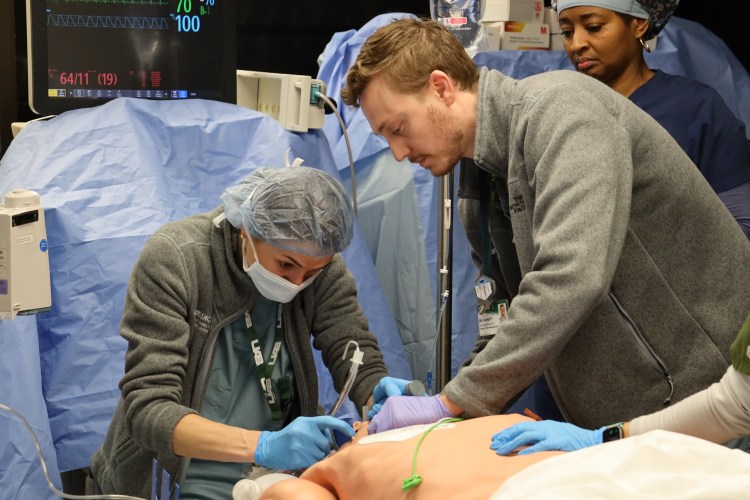Pain Fellows sim preps learners for rare medical emergencies

Through a special simulation, UAB Clinical Simulation helps participants in the UAB Heersink School of Medicine’s (HSOM) Pain Medicine Fellowship improve their readiness, skills and confidence.
Open to pain fellows and nursing staff, the course ultimately leads to better patient care and outcomes, according to Dr. Peter Nagi, facilitator, associate professor and interim vice chair of the Pain Division in HSOM’s Department of Anesthesiology and Perioperative Medicine.
“Our Pain Fellow simulation course provides Pain Fellows and interventional pain clinic staff an opportunity to participate in simulation of rare medical emergencies,” Nagi said. “Because interventional pain procedures are often performed in ambulatory and office-based clinics, these settings are often not equipped with the same resources as inpatient medical centers.”
With that in mind, the course provides hands-on experience in managing various medical emergencies in such remote settings, Nagi said, allowing pain fellows and staff to practice clinical skills, critical decision-making and communication in a controlled environment before facing them in real life.
“This will hopefully allow them to be better and safer physicians,” said Dr. Alethia Sellers, facilitator and associate professor and career advisor in the Department of Anesthesiology.
Sellers described the most recent session, held this past February, as a success.
“The learners expressed that they were nervous initially, but once everything started, they understood that the main purpose is to learn to become better medical team members for their patients,” she said.
Preparedness and communication are key, Nagi added.
“After this experience, our learners invariably re-enter their practice locations with an eye for emergency planning,” he said. “Also, all learners leave this experience with an appreciation for teamwork and effective communication. Our simulation course challenges participants to think critically and make informed decisions under pressure, preparing them to respond effectively to emergency situations in real clinical settings.”
The course has been helping train pain fellows for nearly 10 years, having been established in 2015. Since then, it’s expanded to include pain clinic nursing staff, Sellers explained.
“The course helps build confidence and competence across our team, enabling them to perform more effectively in real-life emergencies,” Nagi said. And according to feedback, the learners agree.
“We’ve been studying our outcomes through pre- and post-participation surveys, in which our participants universally agree or strongly agree that this experience was valuable, and they anticipate it improving their performance in the actual clinical setting,” Nagi said.
UAB Medicine’s Clinical Simulation program offers opportunities for individuals and teams across UAB Medicine and beyond to practice before they deliver care. We encourage all who provide and support patient care to “SimFirst.” Together, we can put our patients’ safety first.




0 Comments